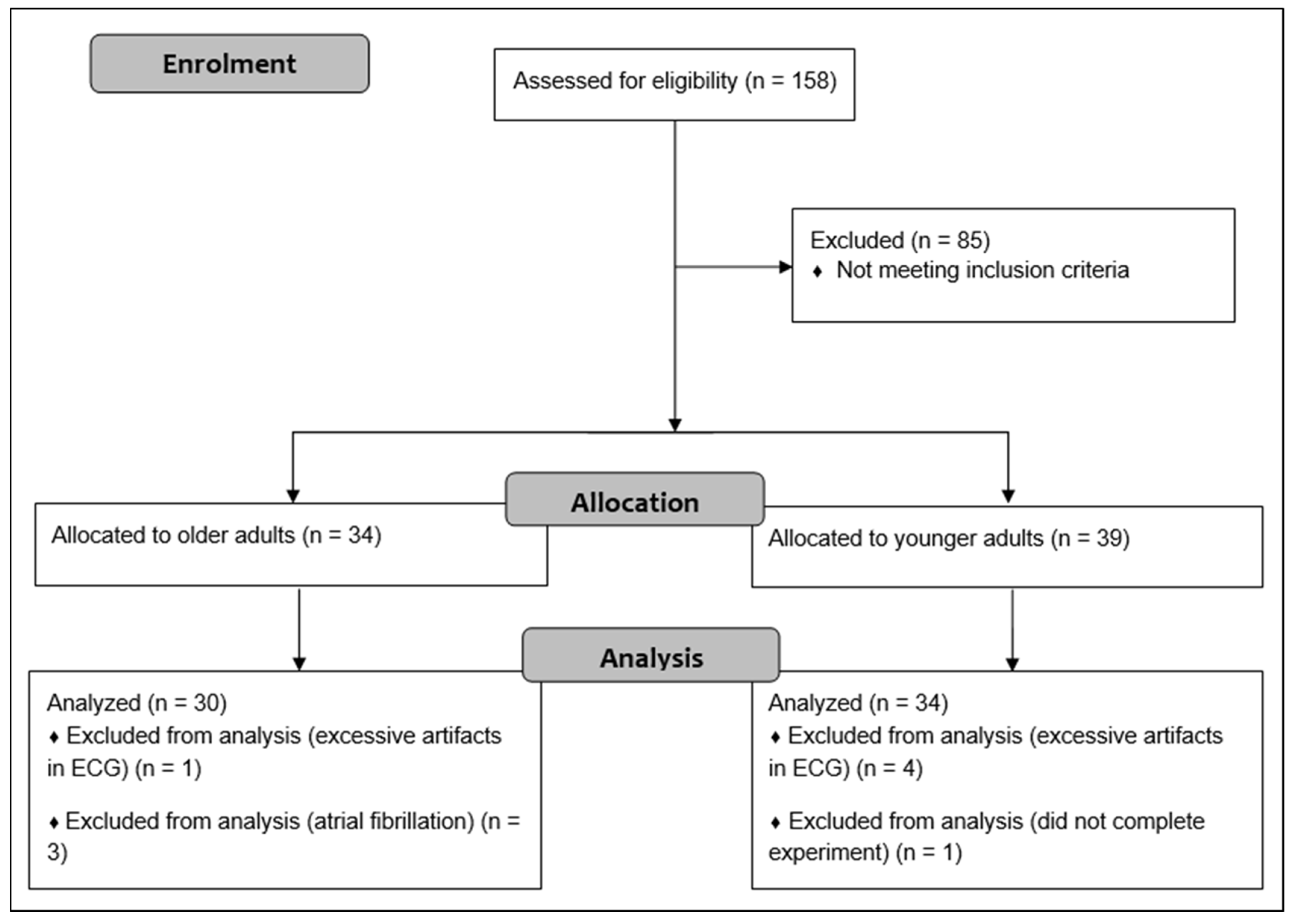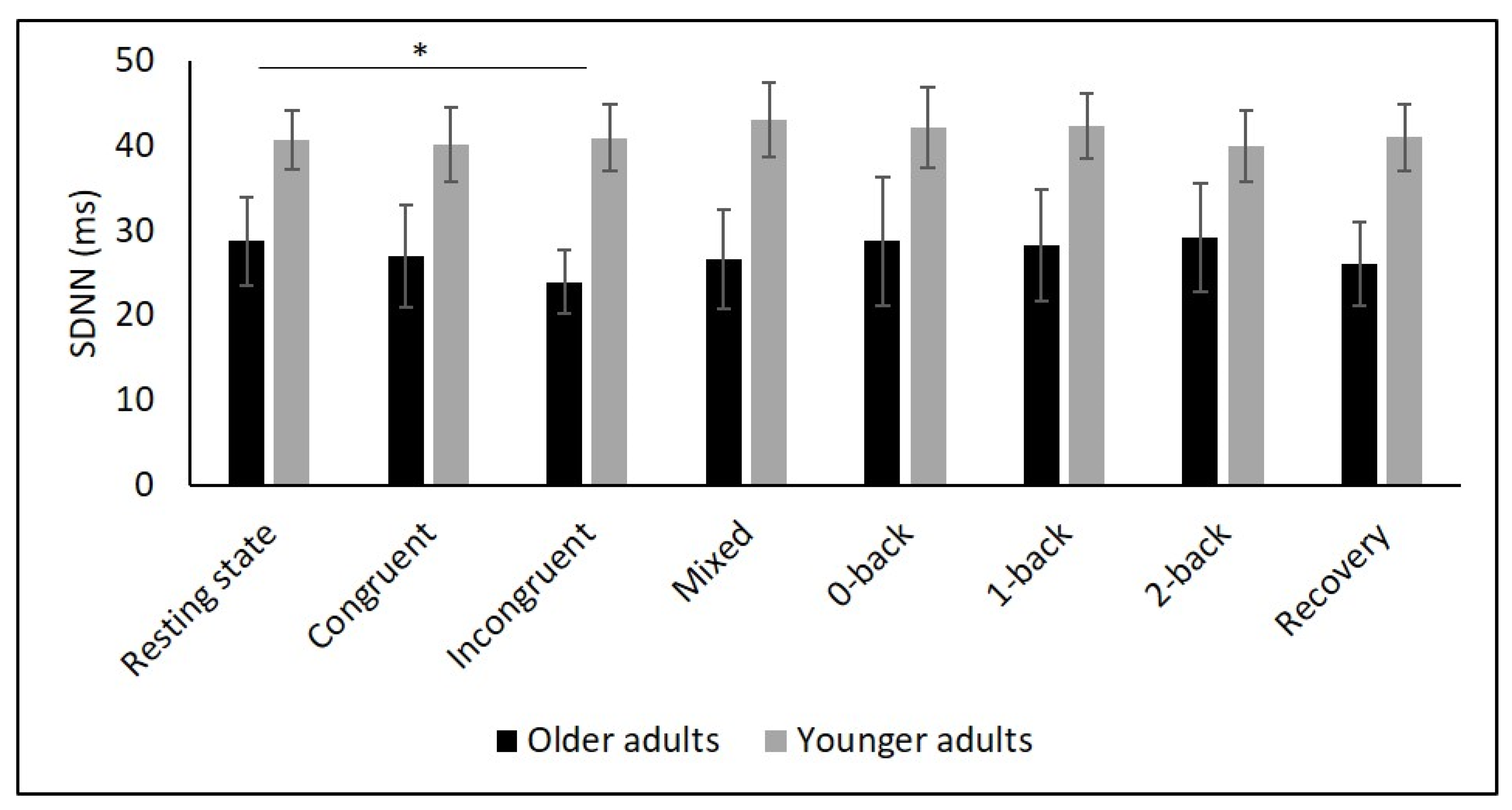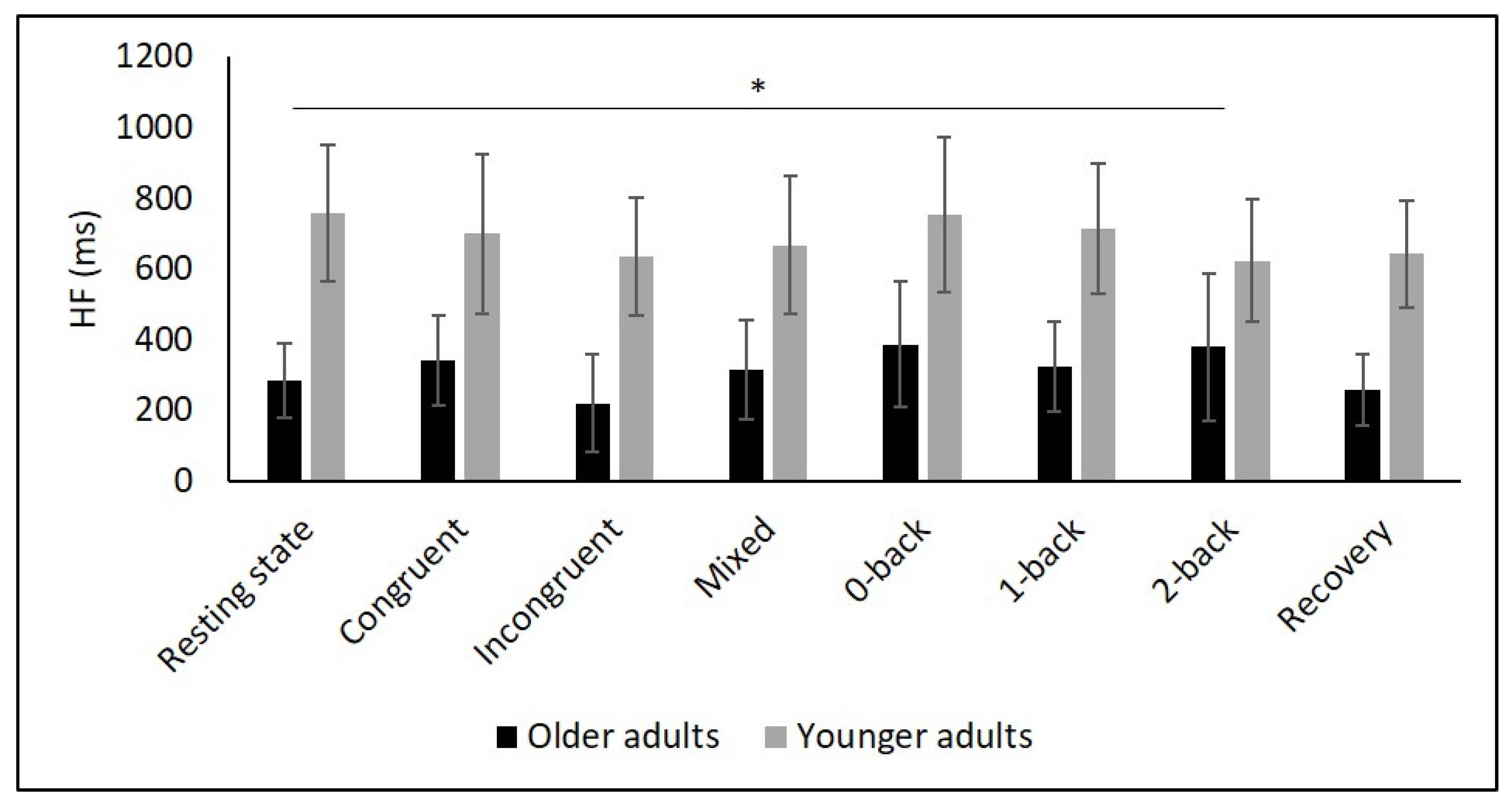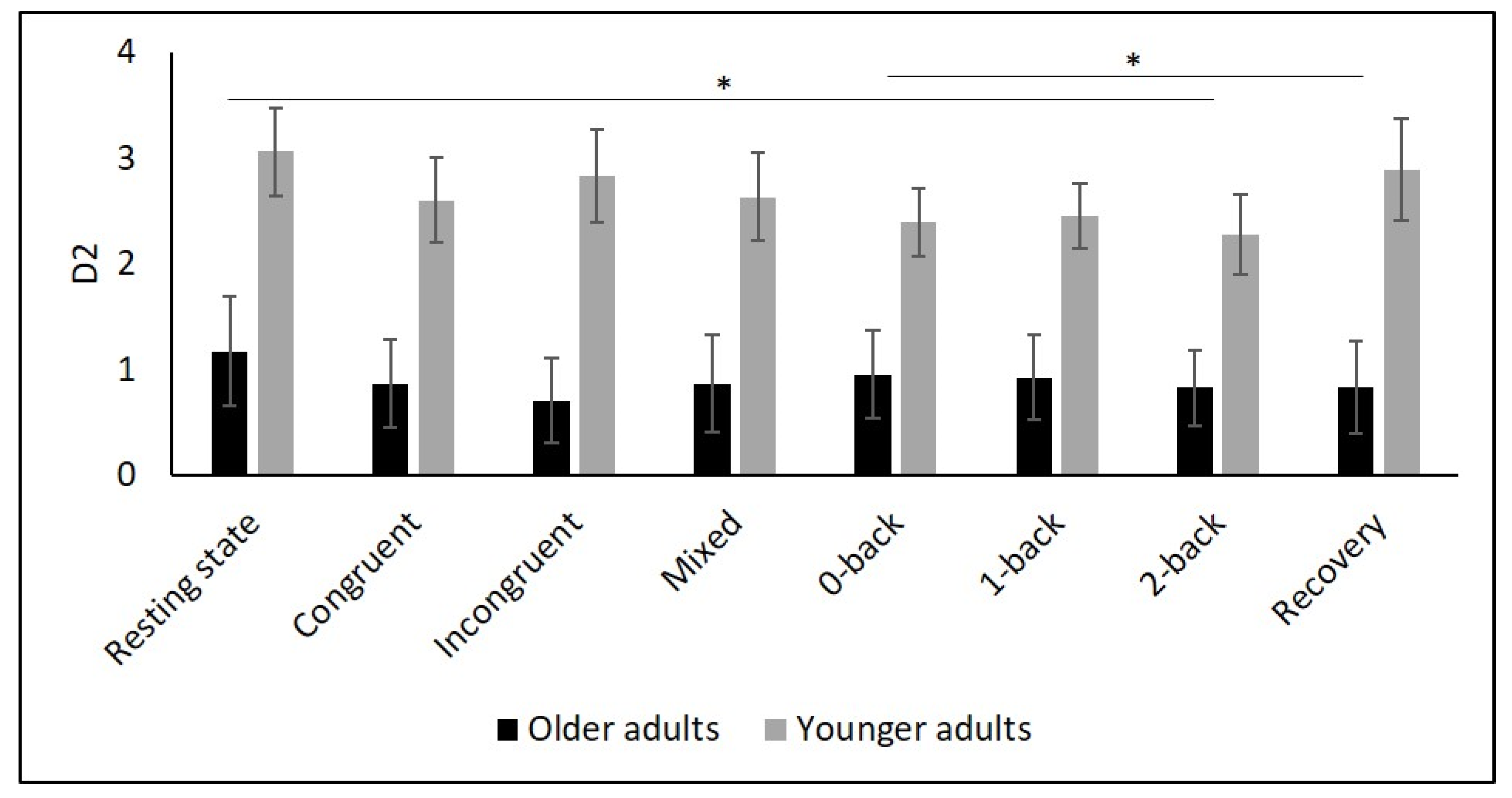Age-Related Differences in Cardiac Autonomic Control at Resting State and in Response to Mental Stress
Abstract
:1. Introduction
2. Materials and Methods
2.1. Participants
2.2. Experimental Design
2.3. Cognitive Tasks
2.4. Autonomic Data Collection and Processing
2.5. Statistical Analysis
2.6. Ethical Approval
3. Results
3.1. Demographic and Behavioral Data
3.2. Autonomic Data
4. Discussion
4.1. Effect of Age on Behavioral Data
4.2. Effects of Age on Mean Heart Rate
4.3. Effects of Age on Cardiac Autonomic Control
4.4. Strengths and Limitations
5. Conclusions
Author Contributions
Funding
Institutional Review Board Statement
Informed Consent Statement
Data Availability Statement
Acknowledgments
Conflicts of Interest
References
- Malik, M. Heart rate variability: Standards of measurement, physiological interpretation, and clinical use. Circulation 1996, 93, 1043–1065. [Google Scholar] [CrossRef] [Green Version]
- Shaffer, F.; Ginsberg, J.P. An Overview of Heart Rate Variability Metrics and Norms. Front. Public Health 2017, 5, 258. [Google Scholar] [CrossRef] [PubMed] [Green Version]
- McCraty, R.; Shaffer, F. Heart rate variability: New perspectives on physiological mechanisms, assessment of self-regulatory capacity, and health risk. Glob. Adv. Health Med. 2015, 4, 46–61. [Google Scholar] [CrossRef] [Green Version]
- Cannon, W.B. Bodily Changes in Pain, Hunger, Fear and Rage: An Account of Recent Researches into the Function of Emotional Excitement; D Appleton & Company: New York, NY, USA, 1915. [Google Scholar]
- Ernst, G. Heart-Rate Variability-More than Heart Beats? Front. Public Health 2017, 5, 240. [Google Scholar] [CrossRef]
- Shaffer, F.; McCraty, R.; Zerr, C.L. A healthy heart is not a metronome: An integrative review of the heart’s anatomy and heart rate variability. Front. Psychol. 2014, 5, 1040. [Google Scholar] [CrossRef] [Green Version]
- La Rovere, M.T.; Pinna, G.D.; Raczak, G. Baroreflex sensitivity: Measurement and clinical implications. Ann. Noninvasive Electrocardiol. 2008, 13, 191–207. [Google Scholar] [CrossRef] [PubMed]
- Sammito, S.; Thielmann, B.; Seibt, R.; Klussmann, A.; Weippert, M.; Böckelmann, I. Guideline for the application of heart rate and heart rate variability in occupational medicine and occupational science. ASUI 2015, 2015, 1–29. [Google Scholar] [CrossRef]
- Laborde, S.; Mosley, E.; Thayer, J.F. Heart rate variability and cardiac vagal tone in psychophysiological research—Recommendations for experiment planning, data analysis, and data reporting. Front. Psychol. 2017, 8, 213. [Google Scholar] [CrossRef] [PubMed] [Green Version]
- Thayer, J.F.; Lane, R.D. The role of vagal function in the risk for cardiovascular disease and mortality. Biol. Psychol. 2007, 74, 224–242. [Google Scholar] [CrossRef]
- de Godoy, M.F. Nonlinear Analysis of Heart Rate Variability: A Comprehensive Review. J. Cardio. Ther. 2016, 3, 528–533. [Google Scholar] [CrossRef]
- Sammito, S.; Böckelmann, I. Factors influencing heart rate variability. ICFJ 2016, 6, 8–22. [Google Scholar] [CrossRef]
- Abhishekh, H.A.; Nisarga, P.; Kisan, R.; Meghana, A.; Chandran, S.; Raju, T.; Sathyaprabha, T. N. Influence of age and gender on autonomic regulation of heart. J. Clin. Monit. Comput. 2013, 27, 259–264. [Google Scholar] [CrossRef]
- Tsuji, H.; Venditti, F.J.; Manders, E.S.; Evans, J.C.; Larson, M.G.; Feldman, C.L.; Levy, D. Reduced heart rate variability and mortality risk in an elderly cohort: The Framingham heart study. Circulation 1994, 90, 878–883. [Google Scholar] [CrossRef] [Green Version]
- Cripps, T.R.; Malik, M.; Farrell, T.G.; Camm, A.J. Prognostic value of reduced heart rate variability after myocardial infarction: Clinical evaluation of a new analysis method. Br. Heart J. 1991, 65, 14–19. [Google Scholar] [CrossRef] [PubMed] [Green Version]
- Kleiger, R.E.; Miller, J.P.; Bigger, J.T.; Moss, A.J. Decreased heart rate variability and its association with increased mortality after acute myocardial infarction. Am. J. Cardiol. 1987, 59, 256–262. [Google Scholar] [CrossRef]
- Thayer, J.F.; Yamamoto, S.S.; Brosschot, J.F. The relationship of autonomic imbalance, heart rate variability and cardiovascular disease risk factors. Int. J. Cardiol. 2010, 141, 122–131. [Google Scholar] [CrossRef]
- Thayer, J.F.; Hansen, A.L.; Saus-Rose, E.; Johnsen, B.H. Heart rate variability, prefrontal neural function, and cognitive performance: The neurovisceral integration perspective on self-regulation, adaptation, and health. Ann. Behav. Med. 2009, 37, 141–153. [Google Scholar] [CrossRef]
- Grässler, B.; Hökelmann, A.; Cabral, R.H. Resting heart rate variability as a possible marker of cognitive decline. Kinesiology (Zagreb Online) 2020, 52, 72–84. [Google Scholar] [CrossRef]
- Forte, G.; Favieri, F.; Casagrande, M. Heart Rate Variability and Cognitive Function: A Systematic Review. Front. Neurosci. 2019, 13, 710. [Google Scholar] [CrossRef]
- Laborde, S.; Mosley, E.; Mertgen, A. Vagal Tank Theory: The Three Rs of Cardiac Vagal Control Functioning—Resting, Reactivity, and Recovery. Front. Neurosci. 2018, 12, 458. [Google Scholar] [CrossRef] [Green Version]
- Manser, P.; Thalmann, M.; Adcock, M.; Knols, R.H.; de Bruin, E.D. Can Reactivity of Heart Rate Variability Be a Potential Biomarker and Monitoring Tool to Promote Healthy Aging? A Systematic Review With Meta-Analyses. Front. Physiol. 2021, 12, 1–28. [Google Scholar] [CrossRef] [PubMed]
- Luque-Casado, A.; Zabala, M.; Morales, E.; Mateo-March, M.; Sanabria, D. Cognitive performance and heart rate variability: The influence of fitness level. PLoS ONE 2013, 8, e56935. [Google Scholar] [CrossRef] [PubMed]
- Luque-Casado, A.; Perales, J.C.; Cárdenas, D.; Sanabria, D. Heart rate variability and cognitive processing: The autonomic response to task demands. Biol. Psychol. 2016, 113, 83–90. [Google Scholar] [CrossRef] [PubMed]
- Canabarro, S.L.S.; Garcia, A.; Satler, C.; Tavares, M.C.H. Interaction between Neural and Cardiac Systems during the Execution of the Stroop Task by Young Adults: Electroencephalographic Activity and Heart Rate Variability. AIMS Neurosci. 2017, 4, 28–51. [Google Scholar] [CrossRef]
- Vazan, R.; Filcikova, D.; Mravec, B. Effect of the Stroop test performed in supine position on the heart rate variability in both genders. Auton. Neurosci. 2017, 208, 156–160. [Google Scholar] [CrossRef]
- Acharya, R.; Kannathal, N.; Sing, O.W.; Ping, L.Y.; Chua, T. Heart rate analysis in normal subjects of various age groups. Biomed. Eng. Online 2004, 3, 24–28. [Google Scholar] [CrossRef] [PubMed] [Green Version]
- Agelink, M.W.; Malessa, R.; Baumann, B.; Majewski, T.; Akila, F.; Zeit, T.; Ziegler, D. Standardized tests of heart rate variability: Normal ranges obtained from 309 healthy humans, and effects of age, gender, and heart rate. Clin. Auton. Res. 2001, 11, 99–108. [Google Scholar] [CrossRef] [PubMed]
- Hernández-Vicente, A.; Hernando, D.; Santos-Lozano, A.; Rodríguez-Romo, G.; Vicente-Rodríguez, G.; Pueyo, E.; Bailón, R.; Garatachea, N. Heart Rate Variability and Exceptional Longevity. Front. Physiol. 2020, 11, 566399. [Google Scholar] [CrossRef]
- Lind, L.; Lampa, E. Lifetime change in central and peripheral haemodynamics in relation to exercise capacity. Clin. Physiol. Funct. Imaging 2019, 39, 261–275. [Google Scholar] [CrossRef] [PubMed]
- Melo, R.C.; Santos, M.D.; Silva, E.; Quitério, R.J.; Moreno, M.A.; Reis, M.S.; Verzola, I.A.; Oliveira, L.; Martins, L.E.; Gallo, L.; et al. Effects of age and physical activity on the autonomic control of heart rate in healthy men. Braz. J. Med. Biol. Res. 2005, 38, 1331–1338. [Google Scholar] [CrossRef] [PubMed] [Green Version]
- Spina, G.D.; Gonze, B.B.; Barbosa, A.C.B.; Sperandio, E.F.; Dourado, V.Z. Presence of age- and sex-related differences in heart rate variability despite the maintenance of a suitable level of accelerometer-based physical activity. Braz. J. Med. Biol. Res. 2019, 52, e8088. [Google Scholar] [CrossRef] [Green Version]
- Sammito, S.; Böckelmann, I. New reference values of heart rate variability during ordinary daily activity. Heart Rhythm 2017, 14, 304–307. [Google Scholar] [CrossRef] [PubMed]
- Capuana, L.J.; Dywan, J.; Tays, W.J.; Segalowitz, S.J. Cardiac workload and inhibitory control in younger and older adults. Biol. Psychol. 2012, 90, 60–70. [Google Scholar] [CrossRef] [PubMed]
- Schapkin, S.A.; Freude, G.; Gajewski, P.D.; Wild-Wall, N.; Falkenstein, M. Effects of working memory load on performance and cardiovascular activity in younger and older workers. Int. J. Behav. Med. 2012, 19, 359–371. [Google Scholar] [CrossRef]
- Stroop, J.R. Studies of interference in serial verbal reactions. J. Exp. Psychol. 1935, 18, 643–662. [Google Scholar] [CrossRef]
- Bélanger, S.; Belleville, S.; Gauthier, S. Inhibition impairments in Alzheimer’s disease, mild cognitive impairment and healthy aging: Effect of congruency proportion in a Stroop task. Neuropsychologia 2010, 48, 581–590. [Google Scholar] [CrossRef]
- Kirchner, W.K. Age differences in short-term retention of rapidly changing information. J. Exp. Psychol. 1958, 55, 352–358. [Google Scholar] [CrossRef]
- Thayer, J.F.; Åhs, F.; Fredrikson, M.; Sollers, J.J.; Wager, T.D. A meta-analysis of heart rate variability and neuroimaging studies: Implications for heart rate variability as a marker of stress and health. Neurosci. Biobehav. Rev. 2012, 36, 747–756. [Google Scholar] [CrossRef]
- van der Elst, W.; van Boxtel, M.P.J.; van Breukelen, G.J.P.; Jolles, J. The Stroop color-word test: Influence of age, sex, and education; and normative data for a large sample across the adult age range. Assessment 2006, 13, 62–79. [Google Scholar] [CrossRef] [Green Version]
- Bopp, K.L.; Verhaeghen, P. Aging and n-Back Performance: A Meta-Analysis. J. Gerontol. B Psychol. Sci. Soc. Sci. 2020, 75, 229–240. [Google Scholar] [CrossRef] [Green Version]
- Faul, F.; Erdfelder, E.; Lang, A.-G.; Buchner, A. G*Power 3: A flexible statistical power analysis program for the social, behavioral, and biomedical sciences. Behav. Res. Methods 2007, 39, 175–191. [Google Scholar] [CrossRef] [PubMed]
- Morris, J.C.; Heyman, A.; Mohs, R.C.; Hughes, J.P.; van Belle, G.; Fillenbaum, G.; Mellits, E.D.; Clark, C. The Consortium to Establish a Registry for Alzheimer’s Disease (CERAD). Part I. Clinical and neuropsychological assessment of Alzheimer’s disease. Neurology 1989, 39, 1159–1165. [Google Scholar] [CrossRef]
- Grässler, B.; Herold, F.; Dordevic, M.; Gujar, T.A.; Darius, S.; Böckelmann, I.; Müller, N.G.; Hökelmann, A. Multimodal measurement approach to identify individuals with mild cognitive impairment: Study protocol for a cross-sectional trial. BMJ Open 2021, 11, e046879. [Google Scholar] [CrossRef] [PubMed]
- Heathers, J.A.J. Everything Hertz: Methodological issues in short-term frequency-domain HRV. Front. Physiol. 2014, 5, 177. [Google Scholar] [CrossRef] [Green Version]
- Huikuri, H.V.; Mäkikallio, T.H.; Perkiömäki, J. Measurement of heart rate variability by methods based on nonlinear dynamics. J. Electrocardiol. 2003, 36, 95–99. [Google Scholar] [CrossRef]
- Cohen, J. Statistical Power Analysis for the Behavioral Sciences, 2nd ed.; Erlbaum: Hillsdale, NJ, USA, 1988; ISBN 9780805802832. [Google Scholar]
- Gajewski, P.D.; Hanisch, E.; Falkenstein, M.; Thönes, S.; Wascher, E. What Does the n-Back Task Measure as We Get Older? Relations Between Working-Memory Measures and Other Cognitive Functions Across the Lifespan. Front. Psychol. 2018, 9, 2208. [Google Scholar] [CrossRef] [PubMed] [Green Version]
- Agbangla, N.F.; Audiffren, M.; Pylouster, J.; Albinet, C.T. Working memory, cognitive load and cardiorespiratory fitness: Testing the CRUNCH model with near-infrared spectroscopy. Brain Sci. 2019, 9, 38. [Google Scholar] [CrossRef] [Green Version]
- Vermeij, A.; van Beek, A.H.E.A.; Olde Rikkert, M.G.M.; Claassen, J.A.H.R.; Kessels, R.P.C. Effects of aging on cerebral oxygenation during working-memory performance: A functional near-infrared spectroscopy study. PLoS ONE 2012, 7, e46210. [Google Scholar] [CrossRef] [PubMed] [Green Version]
- Dupuy, O.; Gauthier, C.J.; Fraser, S.A.; Desjardins-Crèpeau, L.; Desjardins, M.; Mekary, S.; Lesage, F.; Hoge, R.D.; Pouliot, P.; Bherer, L. Higher levels of cardiovascular fitness are associated with better executive function and prefrontal oxygenation in younger and older women. Front. Hum. Neurosci. 2015, 9, 66. [Google Scholar] [CrossRef] [Green Version]
- Zurrón, M.; Lindín, M.; Galdo-Alvarez, S.; Díaz, F. Age-related effects on event-related brain potentials in a congruence/incongruence judgment color-word Stroop task. Front. Aging Neurosci. 2014, 6, 128. [Google Scholar] [CrossRef] [Green Version]
- Mutter, S.A.; Naylor, J.C.; Patterson, E.R. The effects of age and task context on Stroop task performance. Mem. Cognit. 2005, 33, 514–530. [Google Scholar] [CrossRef] [PubMed] [Green Version]
- Head, D.; Rodrigue, K.M.; Kennedy, K.M.; Raz, N. Neuroanatomical and cognitive mediators of age-related differences in episodic memory. Neuropsychology 2008, 22, 491–507. [Google Scholar] [CrossRef] [PubMed] [Green Version]
- Valentini, M.; Parati, G. Variables Influencing Heart Rate. Prog. Cardiovasc. Dis. 2009, 52, 11–19. [Google Scholar] [CrossRef] [PubMed]
- Mathewson, K.J.; Jetha, M.K.; Drmic, I.E.; Bryson, S.E.; Goldberg, J.O.; Hall, G.B.; Santesso, D.L.; Segalowitz, S.J.; Schmidt, L.A. Autonomic predictors of Stroop performance in young and middle-aged adults. Int. J. Psychophysiol. 2010, 76, 123–129. [Google Scholar] [CrossRef] [PubMed]
- de Meersman, R.E.; Stein, P.K. Vagal modulation and aging. Biol. Psychol. 2007, 74, 165–173. [Google Scholar] [CrossRef] [PubMed]
- Levy, W.C.; Cerqueira, M.D.; Harp, G.D.; Johannessen, K.-A.; Abrass, I.B.; Schwartz, R.S.; Stratton, J.R. Effect of endurance exercise training on heart rate variability at rest in healthy young and older men. Am. J. Cardiol. 1998, 82, 1236–1241. [Google Scholar] [CrossRef]
- Jennings, J.R.; Nebes, R.D.; Yovetich, N.A. Aging increases the energetic demands of episodic memory: A cardiovascular analysis. J. Exp. Psychol. Gen. 1990, 119, 77–91. [Google Scholar] [CrossRef]
- Umetani, K.; Singer, D.H.; McCraty, R.; Atkinson, M. Twenty-Four Hour Time Domain Heart Rate Variability and Heart Rate: Relations to Age and Gender Over Nine Decades. J. Am. Coll. Cardiol. 1998, 31, 593–601. [Google Scholar] [CrossRef]
- Zhang, J. Effect of age and sex on heart rate variability in healthy subjects. J. Manipulative Physiol. Ther. 2007, 30, 374–379. [Google Scholar] [CrossRef]
- Felber Dietrich, D.; Schindler, C.; Schwartz, J.; Barthélémy, J.-C.; Tschopp, J.-M.; Roche, F.; von Eckardstein, A.; Brändli, O.; Leuenberger, P.; Gold, D.R.; et al. Heart rate variability in an ageing population and its association with lifestyle and cardiovascular risk factors: Results of the SAPALDIA study. Europace 2006, 8, 521–529. [Google Scholar] [CrossRef] [PubMed]
- Bristow, J.D.; Gribbin, B.; Honour, A.J.; Pickering, T.G.; Sleight, P. Diminished baroreflex sensitivity in high blood pressure and ageing man. J. Physiol. 1969, 202, 45P–46P. [Google Scholar]
- Byrne, E.A.; Fleg, J.L.; Vaitkevicius, P.V.; Wright, J.; Porges, S.W. Role of aerobic capacity and body mass index in the age-associated decline in heart rate variability. J. Appl. Physiol. (1985) 1996, 81, 743–750. [Google Scholar] [CrossRef]
- Berntson, G.G.; Cacioppo, J.T.; Tassinary, L.G. (Eds.) Handbook of Psychophysiology; Cambridge University Press: Cambridge, UK, 2017; ISBN 9781107415782. [Google Scholar]
- Billman, G.E. The LF/HF ratio does not accurately measure cardiac sympatho-vagal balance. Front. Physiol. 2013, 4, 26. [Google Scholar] [CrossRef] [PubMed] [Green Version]
- Sakaki, M.; Yoo, H.J.; Nga, L.; Lee, T.-H.; Thayer, J.F.; Mather, M. Heart rate variability is associated with amygdala functional connectivity with MPFC across younger and older adults. NeuroImage 2016, 139, 44–52. [Google Scholar] [CrossRef] [Green Version]
- Junior, E.C.; Oliveira, F.M. Attenuation of vagal modulation with aging: Univariate and bivariate analysis of HRV. Annu. Int. Conf. IEEE Eng. Med. Biol. Soc. 2017, 2017, 3178–3181. [Google Scholar] [CrossRef] [PubMed]
- Harris, D. Engineering Psychology and Cognitive Ergonomics. In Proceedings of the 7th International Conference, EPCE 2007, Held as Part of HCI International 2007, Beijing, China, 22–27 July 2007; Springer: Berlin/Heidelberg, Germany, 2007. ISBN 3-540-73330-2. [Google Scholar]
- Boutcher, S.H.; Stocker, D. Cardiovascular response of young and older males to mental challenge. J. Gerontol.—Ser. B Psychol. Sci. Soc. Sci. 1996, 51, P261–P267. [Google Scholar] [CrossRef] [PubMed] [Green Version]
- Kudielka, B.M.; Buske-Kirschbaum, A.; Hellhammer, D.H.; Kirschbaum, C. Differential heart rate reactivity and recovery after psychosocial stress (TSST) in healthy children, younger adults, and elderly adults: The impact of age and gender. Int. J. Behav. Med. 2004, 11, 116–121. [Google Scholar] [CrossRef] [PubMed] [Green Version]
- Hockey, R. (Ed.) Operator Functional State. The Assessment and Prediction of Human Performance Degradation in Complex Tasks. In NATO Advanced Research Workshop on Operator Functional State and Impaired Performance in Complex Work Environments, Ciocco, Italy, 3–7 April 2002; IOS Press: Amsterdam, The Netherlands, 2003; ISBN 158603362X. [Google Scholar]
- Ogoh, S.; Tarumi, T. Cerebral blood flow regulation and cognitive function: A role of arterial baroreflex function. J. Physiol. Sci. 2019, 69, 813–823. [Google Scholar] [CrossRef] [PubMed]






| Variable | OA (n = 30) | YA (n = 34) | p-Value | Effect Size d |
|---|---|---|---|---|
| Age (years) | 68.3 ± 6.6 | 24.2 ± 2.9 | <0.001 a*** | 3.650 |
| Male/female (n) | 6/24 | 11/23 | 0.264 b | 0.140 |
| Height (cm) | 164.67 ± 6.37 | 173.62 ± 10.45 | <0.001 a*** | 1.995 |
| Bodyweight (kg) | 67.48 ± 11.22 | 68.75 ± 11.05 | 0.650 a | 0.020 |
| BMI (kg/m2) | 24.82 ± 3.42 | 22.78 ± 3.02 | 0.014 a* | 0.357 |
| Reaction time Stroop congruent (ms) | 912 ± 170 | 590 ± 73 | <0.001 a*** | 2.530 |
| Error rate Stroop congruent (%) | 1.50 ± 1.34 | 1.67 ± 1.59 | 0.594 a | 0.115 |
| Reaction time Stroop incongruent (ms) | 1145 ± 275 | 623 ± 84 | <0.001 a*** | 2.639 |
| Error rate Stroop incongruent (%) | 3.11 ± 3.93 | 2.40 ± 1.60 | 0.359 a | 0.242 |
| Reaction time Stroop mix (ms) | 1034 ± 265 | 603 ± 77 | <0.001 a*** | 2.271 |
| Error rate Stroop mix (%) | 1.67 ± 2.14 | 1.83 ± 1.58 | 0.729 a | 0.086 |
| Reaction time 0-back (ms) | 462 ± 59 | 397 ± 53 | <0.001 a*** | 1.163 |
| Error rate 0-back (%) | 0.00 ± 0.00 | 0.20 ± 0.50 | 0.023 a* | 0.548 |
| Reaction time 1-back (ms) | 478 ± 93 | 401 ± 70 | <0.001 a*** | 0.944 |
| Error rate 1-back (%) | 0.17 ± 0.67 | 0.08 ± 0.32 | 0.491 a | 0.175 |
| Reaction time 2-back (ms) | 564 ± 116 | 483 ± 92 | 0.003 a** | 0.779 |
| Error rate 2-back (%) | 3.39 ± 3.85 | 0.63 ± 0.84 | 0.001 a** | 1.021 |
| mHR (bpm) | SDNN (ms) | RMSSD (ms) | HF (ms2) | LF (ms2) | D2 | |||||||
|---|---|---|---|---|---|---|---|---|---|---|---|---|
| OA | YA | OA | YA | OA | YA | OA | YA | OA | YA | OA | YA | |
| Resting state | 63.95 ± 1.29 | 72.32 ± 1.21 | 28.73 ± 2.61 | 40.61 ± 1.75 | 27.71 ± 2.72 | 38.73 ± 2.50 | 283.60 ± 53.06 | 756.93 ± 96.63 | 546.73 ± 143.64 | 781.77 ± 93.70 | 1.17 ± 0.26 | 3.06 ± 0.21 |
| Stroop congruent | 67.20 ± 1.43 | 72.43 ± 1.24 | 26.94 ± 3.00 | 40.20 ± 2.19 | 30.35 ± 3.18 | 42.98 ± 3.20 | 341.48 ± 63.75 | 697.93 ± 112.04 | 0.86 ± 0.21 | 2.60 ± 0.20 | ||
| Stroop incongruent | 68.14 ± 1.42 | 72.54 ± 1.23 | 23.94 ± 1.85 | 40.91 ± 1.95 | 25.95 ± 2.14 | 41.76 ± 2.63 | 218.08 ± 68.93 | 635.10 ± 83.54 | 0.70 ± 0.20 | 2.83 ± 0.22 | ||
| Stroop mix | 66.94 ± 1.32 | 73.02 ± 1.20 | 26.57 ± 2.91 | 42.98 ± 2.20 | 26.80 ± 2.79 | 42.46 ± 2.84 | 314.59 ± 70.93 | 666.32 ± 97.66 | 0.86 ± 0.23 | 2.63 ± 0.21 | ||
| 0-back | 63.83 ± 1.23 | 71.12 ± 1.25 | 28.73 ± 3.76 | 42.12 ± 2.41 | 30.98 ± 3.81 | 43.94 ± 3.24 | 386.29 ± 89.86 | 752.55 ± 109.00 | 0.95 ± 0.21 | 2.39 ± 0.16 | ||
| 1-back | 64.27 ± 1.28 | 72.16 ± 1.23 | 28.29 ± 3.31 | 42.29 ± 1.94 | 30.25 ± 3.38 | 42.25 ± 2.43 | 323.65 ± 63.42 | 712.30 ± 92.67 | 0.92 ± 0.20 | 2.45 ± 0.15 | ||
| 2-back | 65.60 ± 1.21 | 72.08 ± 1.35 | 29.13 ± 3.20 | 39.89 ± 2.10 | 29.82 ± 3.52 | 40.74 ± 2.90 | 377.61 ± 103.86 | 622.37 ± 86.54 | 0.82 ± 0.18 | 2.27 ± 0.19 | ||
| Recovery | 63.13 ± 1.36 | 71.72 ± 1.27 | 26.09 ± 2.46 | 40.98 ± 1.94 | 25.78 ± 2.54 | 37.85 ± 2.00 | 257.04 ± 51.18 | 640.73 ± 76.16 | 448.84 ± 685.49 | 945.12 ± 126.95 | 0.83 ± 0.22 | 2.89 ± 0.24 |
| Resting State | Recovery | |||||||||
|---|---|---|---|---|---|---|---|---|---|---|
| mHR | SDNN | RMSSD | HF | D2 | mHR | SDNN | RMSSD | HF | D2 | |
| Stroop congruent | 0.004 ** | 0.530 | 0.567 | 0.122 | 0.568 | 0.004 ** | 0.556 | 0.871 | 0.786 | 0.260 |
| Stroop incongruent | <0.001 *** | 0.032 * | 0.103 | 0.472 | 0.424 | <0.001 *** | 0.409 | 0.241 | 0.644 | 0.838 |
| Stroop mix | 0.024 * | 0.098 | 0.097 | 0.211 | 0.638 | 0.005 ** | 0.621 | 0.181 | 0.715 | 0.303 |
| 0-back | 0.239 | 0.686 | 0.552 | 0.386 | 0.149 | 0.114 | 0.520 | 0.773 | 0.840 | 0.040 * |
| 1-back | 0.621 | 0.455 | 0.756 | 0.467 | 0.259 | 0.365 | 0.734 | 0.978 | 0.951 | 0.079 |
| 2-back | 0.093 | 0.667 | 0.974 | 0.030 * | 0.157 | 0.021 * | 0.141 | 0.719 | 0.141 | 0.042 * |
Publisher’s Note: MDPI stays neutral with regard to jurisdictional claims in published maps and institutional affiliations. |
© 2021 by the authors. Licensee MDPI, Basel, Switzerland. This article is an open access article distributed under the terms and conditions of the Creative Commons Attribution (CC BY) license (https://creativecommons.org/licenses/by/4.0/).
Share and Cite
Grässler, B.; Dordevic, M.; Darius, S.; Vogelmann, L.; Herold, F.; Langhans, C.; Halfpaap, N.; Böckelmann, I.; Müller, N.G.; Hökelmann, A. Age-Related Differences in Cardiac Autonomic Control at Resting State and in Response to Mental Stress. Diagnostics 2021, 11, 2218. https://doi.org/10.3390/diagnostics11122218
Grässler B, Dordevic M, Darius S, Vogelmann L, Herold F, Langhans C, Halfpaap N, Böckelmann I, Müller NG, Hökelmann A. Age-Related Differences in Cardiac Autonomic Control at Resting State and in Response to Mental Stress. Diagnostics. 2021; 11(12):2218. https://doi.org/10.3390/diagnostics11122218
Chicago/Turabian StyleGrässler, Bernhard, Milos Dordevic, Sabine Darius, Lukas Vogelmann, Fabian Herold, Corinna Langhans, Nicole Halfpaap, Irina Böckelmann, Notger G. Müller, and Anita Hökelmann. 2021. "Age-Related Differences in Cardiac Autonomic Control at Resting State and in Response to Mental Stress" Diagnostics 11, no. 12: 2218. https://doi.org/10.3390/diagnostics11122218







